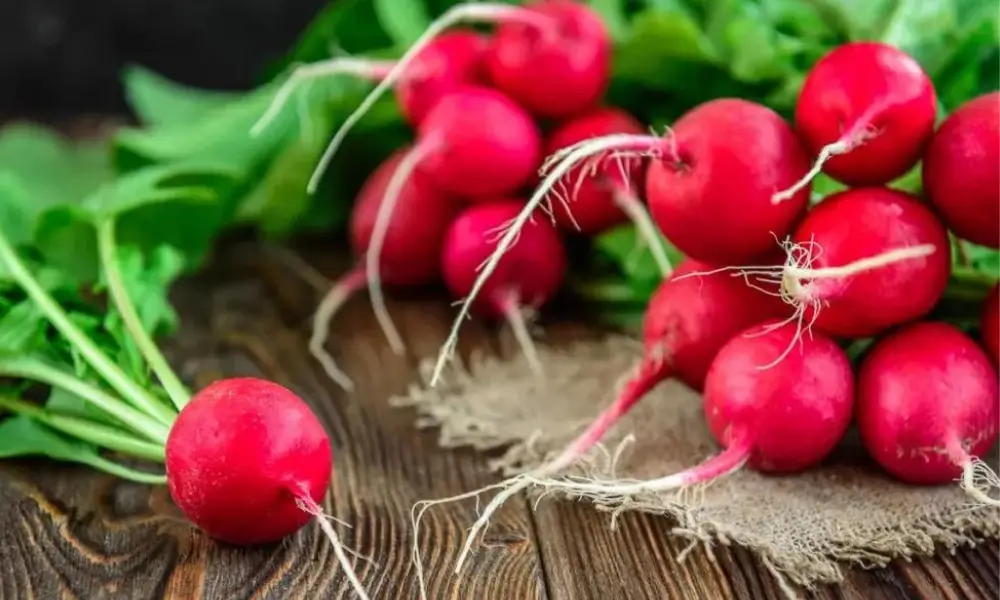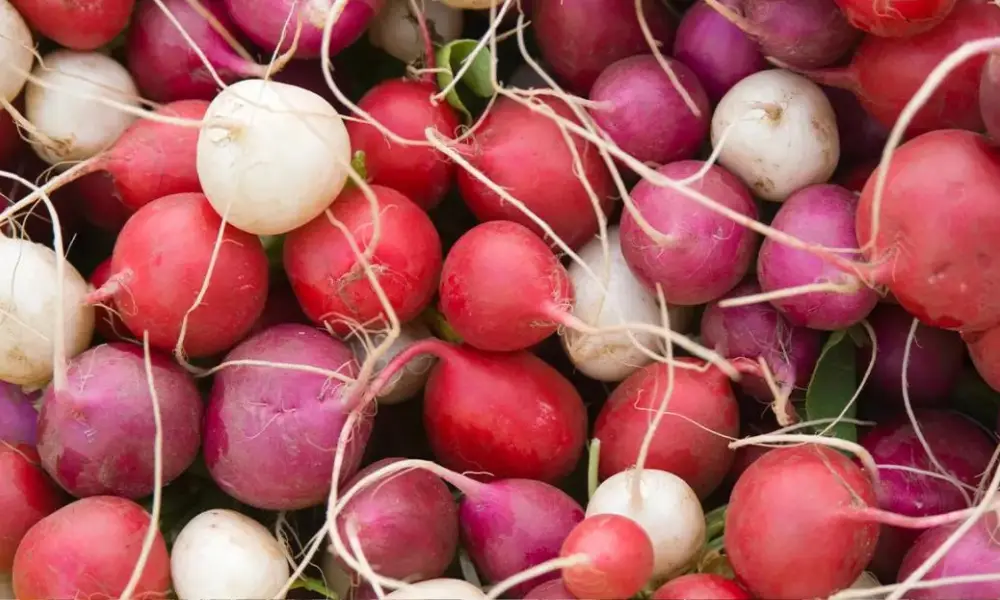You may wonder how to store radishes without putting much effort into it. Radishes can be stored at room temperature; place unwashed radishes in a large bowl and fill it with cold water. Be sure to keep the leaves out of the water. This process will keep radishes fresh for about a week. You can also freeze them for later use.

What is Radish?
A member of the mustard family Brassicaceae, the radish (Raphanus raphanistrum subsp. sativus) is a widely available root vegetable. Fresh radish bulbs are renowned for their flavorful, crisp textures. Some chefs also sauté or add radish greens to salads. Also popular are daikon radishes, which resemble white carrots.
Radishes are a low-maintenance crop that can be grown in various situations and are a good choice for beginning gardeners. Because they have a tap root structure that allows them to thrive, radishes are perfect for gardens with loamy soil or even moist sand-based soil. They frequently sprout as one of the first spring crops and make good companion plants for lettuce, peas, and cucumbers.
Globes, another name for radish bulbs, come in various sizes and hues. The most common radish cultivar in the US is brilliant red and shaped like a little Ping-Pong ball. White, purple, or black variants are also available, and they could have an oblong shape and be more extensive. While some radishes may be sweet, most have a spicy flavor. The winter daikon radish, white, is one of the lighter-colored kinds with a milder flavor. If radishes aren’t eaten soon away or aren’t eaten right away, they get too smelly. The most flavorful and tender radishes are typically the smaller ones.
How to Store Radishes?
Unwashed radishes will get mushy if left on the kitchen counter at room temperature for several days. Fortunately, there are a few simple methods for keeping radishes fresh for both short- and long-term use.
- In cold water: Whole radishes can be stored in a jar of cold water for more than a week. Wash the vegetables, trim the ends of the radish greens, and put them in a water-filled jar with a tight lid. They can be stored for at least a week in the refrigerator.
- Frozen: Radishes lose some characteristic aromas when frozen, but this method is still possible for long-term storage. For the best results, blanch quartered or sliced radishes for two minutes apiece in a large bowl of boiling water followed by a bowl of ice water. To remove the extra moisture, pat them dry with a paper towel. Then, for long-term storage, put the chopped radishes into freezer bags. To avoid ice crystal formation, press out extra air from the plastic bag.
- Pickled: In a chilled canning jar, pickled radishes can keep for up to six months. Use a one-half pound of radishes to one-half cup of white vinegar, one-half cup of sugar, one-quarter cup of water, and one teaspoon of salt when pickling radishes. You can also include ingredients like lemon juice and black pepper to taste.
- In dirt: You can keep radishes in dirt or moist sand to replicate their native climate if you have a root cellar or a chilly space in your basement. Radishes can keep for up to three months when stored in this manner.
- Dehydrated: If you have a dehydrator, you might try drying out radishes to preserve them. Remember that these vegetables have a high water content, so drying them out may cause them to lose their characteristic flavor and texture.
- In the Crisper Drawer: Radishes saved in your crisper drawer are unquestionably the easiest DIY option. However, they might not last as long as those stored in other ways. Radishes can be stored in a food storage bag with a damp paper towel wrapped around them and put in the refrigerator’s crisper drawer. Your radishes might last up to a week if they are very fresh.
For How Long Radishes are Still Fresh?
Your manner of storage affects how fresh your radishes will be.
- Kitchen counter: Radish greens and bulbs will wilt and turn mushy if left on a kitchen counter for more than two to three days.
- Plastic bag: Radishes can stay fresh for five to seven days when kept in the crisper drawer of your refrigerator.
- Water-filled container: Radishes can keep for up to two weeks in a jar full of cold water.
- Dirt: Radishes can be kept for up to three months in the land of a root cellar.
- Pickled: Radishes can easily be kept pickled for six months.
- Frozen: Radishes can be frozen or dehydrated and kept for six months to a year, although their particular flavor and texture may not be as well preserved.
How to Prepare Radishes?
The most popular ways to serve radishes are fresh, halved, and salt-sprinkled, shaved into salads, piled over butter-smeared baguettes, or shredded into slaws. They can also be pickled with a traditional vinegar-sugar-salt mixture or marinated in olive oil with lemon and mint for a flavorful salad. A spicy and crunchy salsa made from finely diced radishes, red onion, jalapenos, cilantro, and lime goes well with any taco.
Additionally, radishes can be roasted at 450°F for 15 to 20 minutes, or until caramelized and soft, with olive oil, salt, and pepper. To make a simple vegetable side dish, they can also be sautéed and puréed with various vegetables (parsnips, potatoes, turnips, etc.). You may thin out this purée and turn it into a soup using chicken or vegetable stock. Putting greens Before cooking, discard any yellow greens. Gardens can be swiftly steamed or sautéed and treated with olive oil or butter, any number of herbs, a squeeze of lemon or vinegar, minced shallots, or both.
What are the Health Benefits of Radish?
They won’t Stop You from Following a Healthy Diet
Sliced radishes won’t ruin your healthy diet because a 1/2-cup portion has 12 calories and almost no fat. When hunger hits, they are the ideal crunchy snack.
A good source of vitamin C is radishes, and only half a cup provides 14% of the daily required amount. Vitamin C is an antioxidant that aids in the fight against free radicals in the body and guards against cell deterioration brought on by aging, leading an unhealthy lifestyle, and exposure to toxins. Generating collagen, which promotes healthy skin and blood vessels, is another essential function of vitamin C.
Anti-Cancer Characteristics
Radishes and other cruciferous veggies can help prevent cancer. According to the Linus Pauling Institute, cruciferous vegetables contain substances that decompose into isothiocyanates when mixed with water. Isothiocyanates aid in tumor prevention and removing cancer-causing agents from the body.
According to a 2010 study, radish root extract contains a variety of isothiocyanates that kill various cancer cell lines.
Reference: Effect of different thawing methods on the efficiency and quality attributes of frozen red radish
Promote the Health of the Digestive System
You get 1 gram of fiber from a serving of 1/2 cup of radishes. Reaching your daily fiber consumption target is made more accessible by eating a few servings daily. By giving your stool more volume to facilitate the passage of waste through your intestines, fiber aids avoid constipation. Additionally, fiber has been connected to weight loss and decreased cholesterol and may help you control your blood sugar levels.
In particular, radish leaves might be advantageous. According to research done in 2008 on rats given a high-cholesterol diet, radish leaves are a rich source of fiber that can help with digestion. The increased production of bile may be partly to blame for this.
According to a different study, radish juice may help prevent stomach ulcers by strengthening the mucosal barrier and safeguarding gastrointestinal tissue. The mucosal barrier protects your stomach and intestines from harmful toxins and germs that can lead to ulcers and inflammation.
Anti-Fungal Attributes
A natural antifungal is radishes, and they include RsAFP2, an antifungal protein. According to one studyTrusted Source, the typical human fungus Candida albicans died due to RsAFP2. Vaginal yeast infections, oral yeast infections (thrush), and invasive candidiasis can all result from Candida albicans overgrowth.
An earlier mouse investigation revealed that RsAFP2 was somewhat effective against additional Candida species in addition to Candida albicans. When used against Candida glabrata strains, RsAFP2 proved ineffective.
Contribute to Lessening the Effects of Zen
A dangerous fungus called zearalenone (zen) infests numerous maize crops and animal feeds. Even though there is little concern for humans, it has been connected to reproductive issues in animals and people. A 2008 studyTrusted Source found that radish extract increased the antioxidant content in mice and can be regarded as a secure method to lessen or stop the impacts of stress.
Some Radish Recipes
Radishes with Garlic & Caraway, Roasted
We won’t get very far without discussing our preferred method for roasting radishes. Garlic and caraway seeds are added to this recipe to enhance the radishes’ earthy flavor; the longer they are roasted, the sweeter and milder they become. Radish doubters will eventually fall in love.
A Delicious Radish and Broccoli Salad
Think outside the box to create a spring-forward slaw that goes beyond traditional cabbage. It goes great with burgers, grilled pork, or your Easter ham. The broccoli stalks you would typically throw away are used in this recipe together with dried cherries, chopped pistachios, and watermelon radishes. I’m not sure what could better scream the praises of spring than this slaw.
Butter and Radish Tartine
The very chicest tartine for spring is made by buttering a slice of toasted bread (use your favorite loaf and the loveliest butter you can find), topping it with extremely thinly sliced radishes, and then finishing it with a liberal sprinkle of flaky sea salt: the perfect springtime snacks, breakfast, and lunch.
Radish Top Aioli
Make this aioli to fully appreciate how versatile radishes are while utilizing every last piece of them. Radish Top Aioli Along with the traditional eggs, lemon juice, Dijon mustard, garlic, and oil, chopped radish leaves are added. It’s the best dipping sauce for radishes, naturally!
When to Consume Radish? What is the Ideal Time for Consuming?
Radish should not be consumed on an empty stomach as this can result in gas-related issues. Additionally, avoid going to bed immediately after ingesting it because that will result in bloating. It is best consumed during lunchtime, and lifting it throughout the day will be fully digested when you go to bed.
Whenever possible, consume radish with black salt to prevent stomach problems from gas. The radish’s acidity is tamed when you have these two together.
It is best to take curd along with radish paratha if you are allergic to radish and experience skin itchiness or stomach problems. Curd counteracts radish’s harmful effects in this way.
What are the Side-Effects & Allergies of Radish?
The diuretic qualities of radish help to increase urine output. However, consuming too much radish would cause an excessive loss of water from our bodies, which could result in dehydration. Consuming too many radishes can lower blood pressure and produce hypoglycemia. Additionally, this vegetable should not be consumed by those with gallstones or pregnant women.
Conclusion
To store radishes properly, wash them thoroughly and put them into a glass jar with clean water. This will keep the radishes fresh for up to eight days, or you can place them in a carton box with damp sand. Rinsing them is essential, as touching the roots will result in rotting. However, if you’re storing them in a glass jar, you should rinse them thoroughly and keep them refrigerated to prevent them from rusting.
